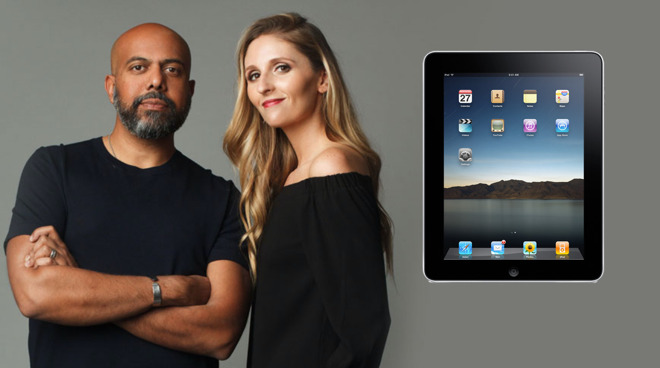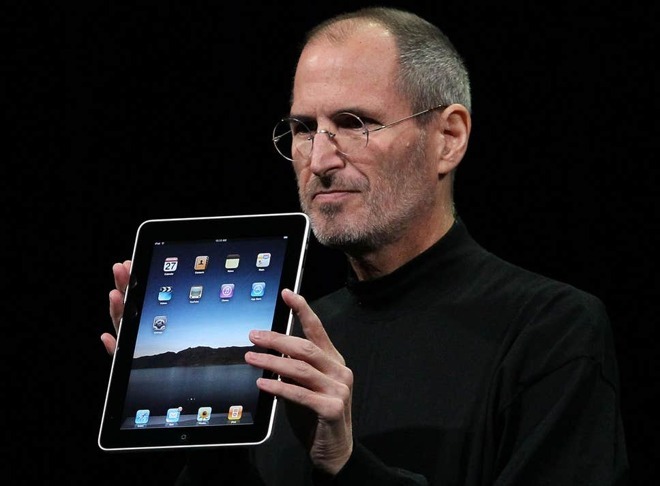Ex-Apple designers detail how the original iPad was created
Bethany Bongiorno and Imran Chaudhri worked on the first iPad back in 2010. Now having left Apple, they've revealed how Steve Jobs drove the teams and what they were surprised by in that original iPad.

Imran Chaudhri (left) and Bethany Bongiorno (right) with the original iPad they worked on (inset)
Now partners in the technology firm Humane, Bethany Bongiorno and Imran Chaudhri were deeply involved in the creation of the first iPad. Bongiorno joined Apple in time to become software engineering director for the iPad project, while Chaudhri is credited with the user interface of the iPhone.
"Steve had this pet project that he was really excited about," Bongiorno told Input magazine. "[It] would be a small team to build this new project codenamed K48. K48 was hardware and Wildcat was the codename for the software. They asked me to lead that initiative, to build the engineering team and to lead the effort for the K48 project, which ultimately became the iPad."
"I think what we originally envisioned was designed as a consumption device," says Chaudhri. "One of the things that Steve had in his, like, mini-brief for it was 'I really want to be able to use this for mail while sitting on the toilet' and that level of consumption and ease was something that went into us wanting it to replace your newspaper and wanting it to replace the books in your life."
Bongiorno and Chaudhri say that what became the iPad was originally worked on much earlier than generally believed. While it's well known now that the iPad efforts predated the iPhone, the designers say it began with a plan to make a multi-touch Mac.
"The story of the iPad goes way back beyond before the phone," says Chaudhri. "It started out as this project called Q79. Q79 was the product that was built around multitouch exploration... At the time, it was looking at bringing a multitouch screen to a Macintosh laptop. Specifically the iBook, at the time."
"It turned out that was a really, really expensive endeavor," he continues, "and it just wasn't really going to be successful for Apple to build a super expensive computer coming off of having released the Cube, which didn't do well. We kind of pulled away from that effort and focused on a much smaller thing, which was the phone."
That original aim was not forgotten, however, and the idea of a desktop computer with multi-touch influenced how the iPad was created.
"When we resurrected the iPad," says Chaudhri, "we knew that it was always designed as a computer and it was literally the perfect playground for multitouch. The phone was the first delivery mechanism but we always knew that we wanted a desktop class face to run applications for multitouch."
The iPad went through countless redesigns. "There were a lot of things that weren't working as we were building it that we completely threw out, fully implemented designs that we had started with, to redefine, and redefine, and redevelop as we were doing it," says Bongiorno.
Even so, it is only when you see customers using a product that you know what is working. Bongiorno says she was surprised to find customers taking photographs with the camera in this large device.
"We actually didn't believe that people would walk around taking pictures with their iPad. It was actually a funny internal conversation when we started seeing people outside taking their iPad with them and taking photos on vacation," she says.

The original iPad from 2010
"I remember very clearly at the 2012 Olympics in London," says Chaudhri, "if you looked around the stadium, you saw a lot of people using an iPad as a camera and generally that was people that just needed to have a bigger viewfinder for vision reasons, etc. Then seeing that, we went back in and redesigned the camera experience on the iPad."
The two are able to recount their iPad stories since they have left Apple to found their new Humane company. They both say that their decision to leave was the desire to form this new firm rather than anything at Apple. However, Input did ask them about the change when Steve Jobs died and Tim Cook took over.
Chaudhri chose to praise Tim Cook's charitable efforts. "I think one of the things I love a lot about Tim's passions is his passion for philanthropy and giving back to a community," he says. "In Steve's days, Apple wasn't as well off, so that wasn't something that was a focus for Steve. But I think the way Tim is doing that is incredibly remarkable. I hope it continues.

Steve Jobs reveals the iPad
Bongiorno equally praises Cook, but does say the company has changed since he replaced Jobs.
"There's no doubt that Tim has built a very successful company and has brought a lot of wealth to Apple shareholders and to the company overall," she says, "and I think that's a testament to the fact that he is the best in the world at operations is he's incredibly innovative on operations."
"But his specialty and his skill set is not in building innovative products, right?" she continues. "Product definition and product development. I think that's something that is just a fact of the change in leadership between him and Steve and the kinds of things that Steve really cared about versus the things that Tim really cares about."
"And I think for people like us who are, you know, really on the creative side and really want to push things," she concludes, "that was definitely more in line with Steve's mission than it was Tim's."

Imran Chaudhri (left) and Bethany Bongiorno (right) with the original iPad they worked on (inset)
Now partners in the technology firm Humane, Bethany Bongiorno and Imran Chaudhri were deeply involved in the creation of the first iPad. Bongiorno joined Apple in time to become software engineering director for the iPad project, while Chaudhri is credited with the user interface of the iPhone.
"Steve had this pet project that he was really excited about," Bongiorno told Input magazine. "[It] would be a small team to build this new project codenamed K48. K48 was hardware and Wildcat was the codename for the software. They asked me to lead that initiative, to build the engineering team and to lead the effort for the K48 project, which ultimately became the iPad."
"I think what we originally envisioned was designed as a consumption device," says Chaudhri. "One of the things that Steve had in his, like, mini-brief for it was 'I really want to be able to use this for mail while sitting on the toilet' and that level of consumption and ease was something that went into us wanting it to replace your newspaper and wanting it to replace the books in your life."
Bongiorno and Chaudhri say that what became the iPad was originally worked on much earlier than generally believed. While it's well known now that the iPad efforts predated the iPhone, the designers say it began with a plan to make a multi-touch Mac.
"The story of the iPad goes way back beyond before the phone," says Chaudhri. "It started out as this project called Q79. Q79 was the product that was built around multitouch exploration... At the time, it was looking at bringing a multitouch screen to a Macintosh laptop. Specifically the iBook, at the time."
"It turned out that was a really, really expensive endeavor," he continues, "and it just wasn't really going to be successful for Apple to build a super expensive computer coming off of having released the Cube, which didn't do well. We kind of pulled away from that effort and focused on a much smaller thing, which was the phone."
That original aim was not forgotten, however, and the idea of a desktop computer with multi-touch influenced how the iPad was created.
"When we resurrected the iPad," says Chaudhri, "we knew that it was always designed as a computer and it was literally the perfect playground for multitouch. The phone was the first delivery mechanism but we always knew that we wanted a desktop class face to run applications for multitouch."
The iPad went through countless redesigns. "There were a lot of things that weren't working as we were building it that we completely threw out, fully implemented designs that we had started with, to redefine, and redefine, and redevelop as we were doing it," says Bongiorno.
Even so, it is only when you see customers using a product that you know what is working. Bongiorno says she was surprised to find customers taking photographs with the camera in this large device.
"We actually didn't believe that people would walk around taking pictures with their iPad. It was actually a funny internal conversation when we started seeing people outside taking their iPad with them and taking photos on vacation," she says.

The original iPad from 2010
"I remember very clearly at the 2012 Olympics in London," says Chaudhri, "if you looked around the stadium, you saw a lot of people using an iPad as a camera and generally that was people that just needed to have a bigger viewfinder for vision reasons, etc. Then seeing that, we went back in and redesigned the camera experience on the iPad."
The two are able to recount their iPad stories since they have left Apple to found their new Humane company. They both say that their decision to leave was the desire to form this new firm rather than anything at Apple. However, Input did ask them about the change when Steve Jobs died and Tim Cook took over.
Chaudhri chose to praise Tim Cook's charitable efforts. "I think one of the things I love a lot about Tim's passions is his passion for philanthropy and giving back to a community," he says. "In Steve's days, Apple wasn't as well off, so that wasn't something that was a focus for Steve. But I think the way Tim is doing that is incredibly remarkable. I hope it continues.

Steve Jobs reveals the iPad
Bongiorno equally praises Cook, but does say the company has changed since he replaced Jobs.
"There's no doubt that Tim has built a very successful company and has brought a lot of wealth to Apple shareholders and to the company overall," she says, "and I think that's a testament to the fact that he is the best in the world at operations is he's incredibly innovative on operations."
"But his specialty and his skill set is not in building innovative products, right?" she continues. "Product definition and product development. I think that's something that is just a fact of the change in leadership between him and Steve and the kinds of things that Steve really cared about versus the things that Tim really cares about."
"And I think for people like us who are, you know, really on the creative side and really want to push things," she concludes, "that was definitely more in line with Steve's mission than it was Tim's."


Comments
In a way this is what Jobs was missing, he had these great revolutionary ideas, but not all of them were compatible with people outside of Apple's strongest fan base, i.e. society at large and he always had a certain arrogance to common society, in that it's the audience's fault that they don't embrace these ideas, rather than the idea simply being untenable. That same arrogance is what also led to a number of failed products (such as the Cube which was mentioned, however are plenty more.) In a way Jobs very much still relied on Apple's strongest fans to keep the company going while he experimented with different ideas.
Second to this Job's didn't really have a vision for the iPad after launch, for years it simply went into decline - it's been under Cook's leadership that the device has found it's own niche, the guy can clearly think further ahead than this own immediate desires.
What made Jobs such a revolutionary in tech was that he wasn't trying to guess what the market wanted. He made the product he wanted to use and made it the best way he could. We hear the same philosophy over and over from those from that era like Ive. We don't hear that so much any more. Jobs didn't try and fulfill the need you thought you had. He figured out what you and everyone else wanted because he wanted it too. And no one knew that that was what they really needed all along until Jobs and crew released. No one knew they needed a touch screen phone, or a table for that matter, until Jobs and his team made the phone and tablet that they themselves wanted to use.
It was actually because he focused on what he wanted, rather than try and guess the whims of the market like Gates was doing, that these innovations happened. Not in spite of it.
[Edit: okay, from the original Input magazine article, it sounds like she led the whole iPad project.]
I agree with @EsquireCats. The most charitable thing they could say about Tim was his charity? It's sad they undermine his contributions with "he's made money for the shareholders, but...".
Leading a Trillion Dollar+ company, actually having a good rapport with a leader on the opposite side of his spectrum, releasing products that are still exciting (Apple Watch, HomePod, iPhone X and beyond, Mac Pro). I think he is doing a phenomenal job.
Expecting a person to be like the person he is replacing is foolishness. Expecting someone to be Steve Jobs 2.0 is beyond madness.
BTW, I'm getting really impatient waiting for the next iPad Pro to release (drop!). I've got money burning a hole in my pocket and since I cannot afford the MacPro, I hope the iPad Pro drops soon!!
I guess someone is not familiar with Indian or South Asian names.
Male name, female name, in America these words are slowly losing their meaning, right? 😏
I wouldn’t have been surprised if it had been the other way round, anyway.
In any case, for the rest of us less civilized people the clarification was welcomed.
🙄
BTW, Since my 10 y.o. Nano 6 died, I've been using my iPhone podcast app to listen to podcasts while I drive. It sucks. I'm buying a new iPod ASAP.